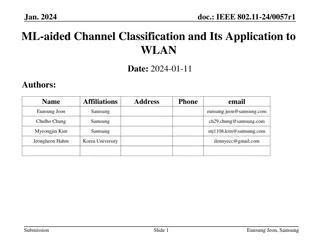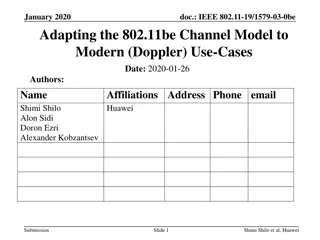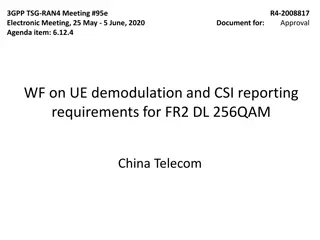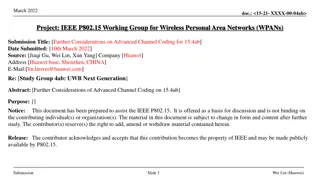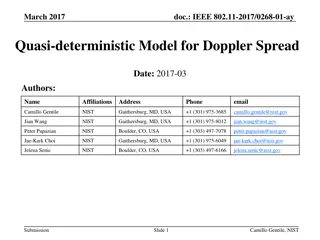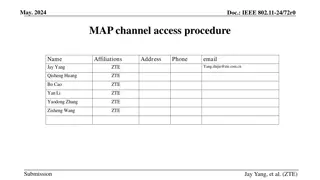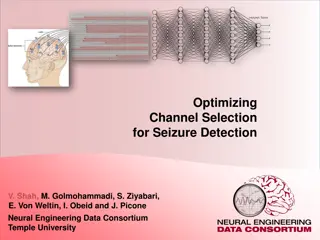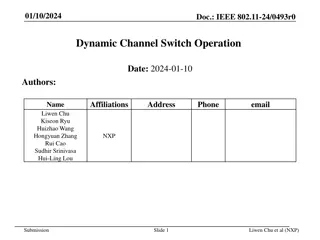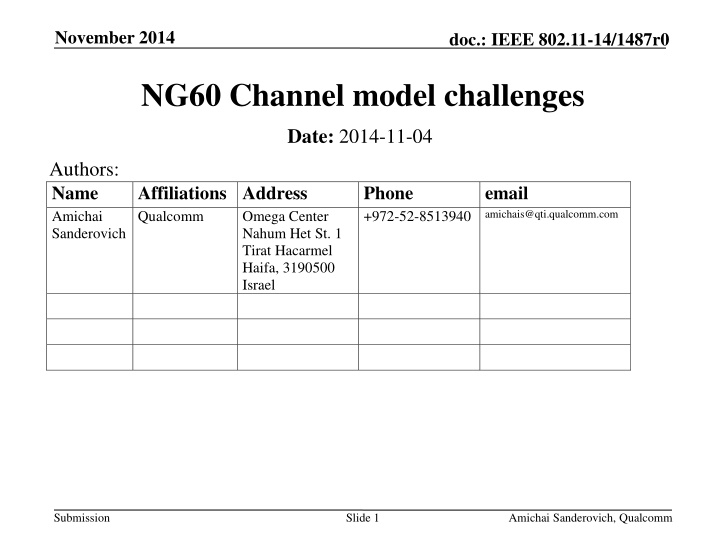
Challenges and Features of IEEE 802.11 NG60 Channel Model
Explore the challenges and features of the IEEE 802.11 NG60 channel model as discussed in the November 2014 document. Topics covered include channel bonding, MIMO technology, antenna frequency responses, outdoor channel considerations, and more, presented by Amichai Sanderovich from Qualcomm.
Download Presentation

Please find below an Image/Link to download the presentation.
The content on the website is provided AS IS for your information and personal use only. It may not be sold, licensed, or shared on other websites without obtaining consent from the author. If you encounter any issues during the download, it is possible that the publisher has removed the file from their server.
You are allowed to download the files provided on this website for personal or commercial use, subject to the condition that they are used lawfully. All files are the property of their respective owners.
The content on the website is provided AS IS for your information and personal use only. It may not be sold, licensed, or shared on other websites without obtaining consent from the author.
E N D
Presentation Transcript
November 2014 doc.: IEEE 802.11-14/1487r0 NG60 Channel model challenges Date: 2014-11-04 Authors: Name Amichai Sanderovich Affiliations Address Qualcomm Phone +972-52-8513940 email amichais@qti.qualcomm.com Omega Center Nahum Het St. 1 Tirat Hacarmel Haifa, 3190500 Israel Submission Slide 1 Amichai Sanderovich, Qualcomm
November 2014 NG60 features required by the channel model doc.: IEEE 802.11-14/1487r0 Channel bonding Multiple streams MIMO Multi-users channel (MU-MIMO): focus on DL-MU- MIMO Interference and dense deployment Outdoor channel Submission Slide 2 Amichai Sanderovich, Qualcomm
November 2014 doc.: IEEE 802.11-14/1487r0 Channel Bonding Non-ideal antenna frequency responses Reflection, penetration and diffraction coefficients @ mmWave are often frequency dependent due to the small wavelength RF circuitry, including the shifters and combiners, have some frequency response Extremely high BW in channel model distinguishes different paths (>4cm apart) More time-domain coefficients are deterministic Outdoor frequency response depends on medium absorption Outdoor channel with Doppler spreads/fast fading Submission Slide 3 Amichai Sanderovich, Qualcomm
November 2014 MIMO/MU-MIMO in the channel model SISO model focuses on the largest singular value MIMO model should predict several singular values and provide correlation between streams, thus model should be extended with Reflections with higher order (3rd were noticed in indoor measurements) Diffraction, especially for NLOS, provides higher rank to the channel matrix Polarity characterization of reflections is required if polarity is to be used for spatial multiplication Antenna array intimately connected to the model: Coupling between subassemblies (S21), and between chains Subassembly patterns: Antenna elements pattern: patch, dipole, Yagi-Uda, combinations RF control circuits: phase resolution, gain resolution Array configuration algorithms included in model SVD which is approximated by the RF circuitry Max SNR approximated by the RF circuitry Max SINR approximated by the RF circuitry Polarity separation of the array Outdoor vs. indoor antennas Outdoor arrays are more directional doc.: IEEE 802.11-14/1487r0 Submission Slide 4 Amichai Sanderovich, Qualcomm
November 2014 doc.: IEEE 802.11-14/1487r0 Summary NG60 channel model is required for evaluations of specifications Channel model should be verified with measurements corresponding to the different scenarios Channel model should account for the unique challenges posed by the NG60, presented in this presentation Submission Slide 5 Amichai Sanderovich, Qualcomm




